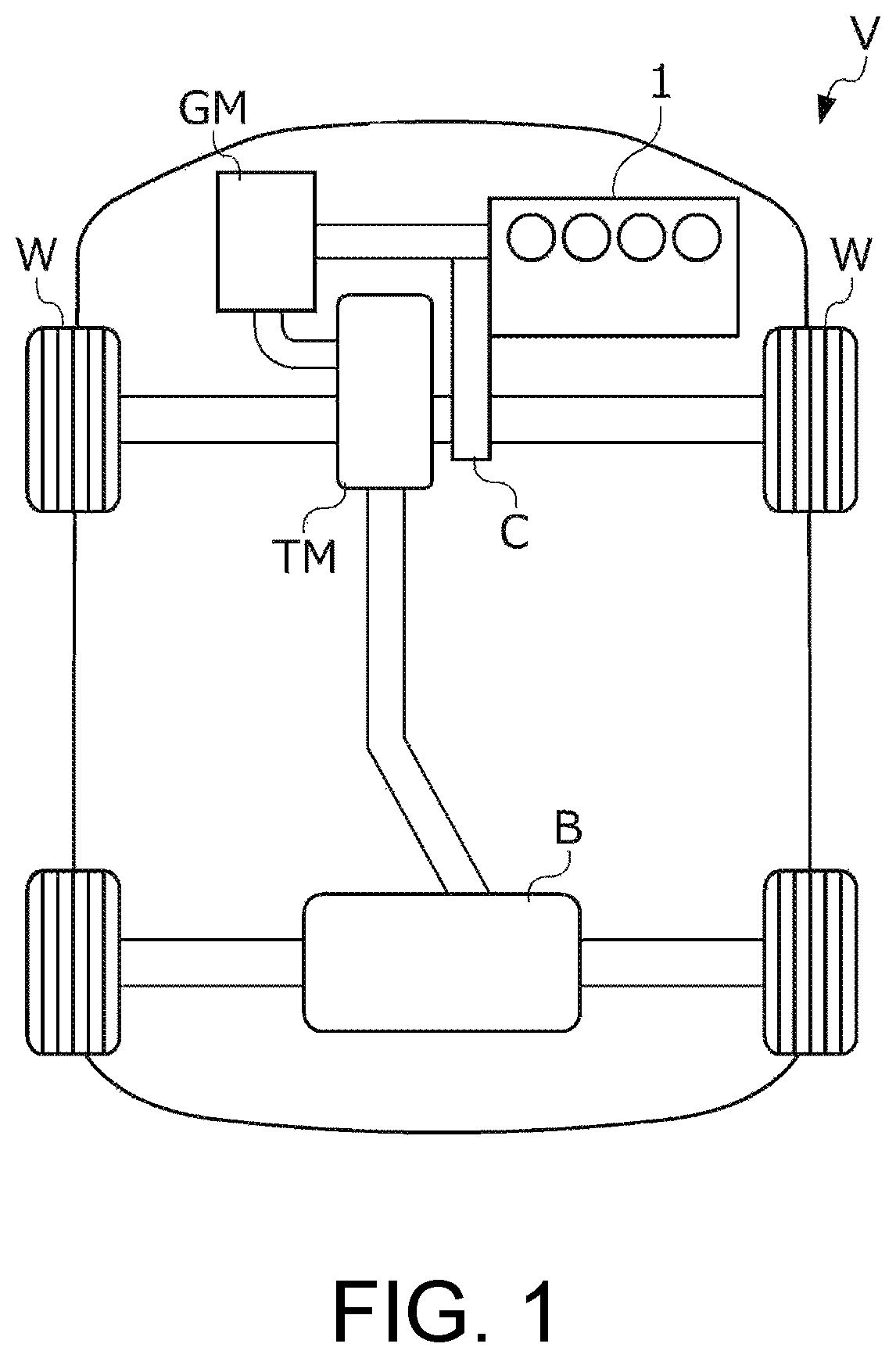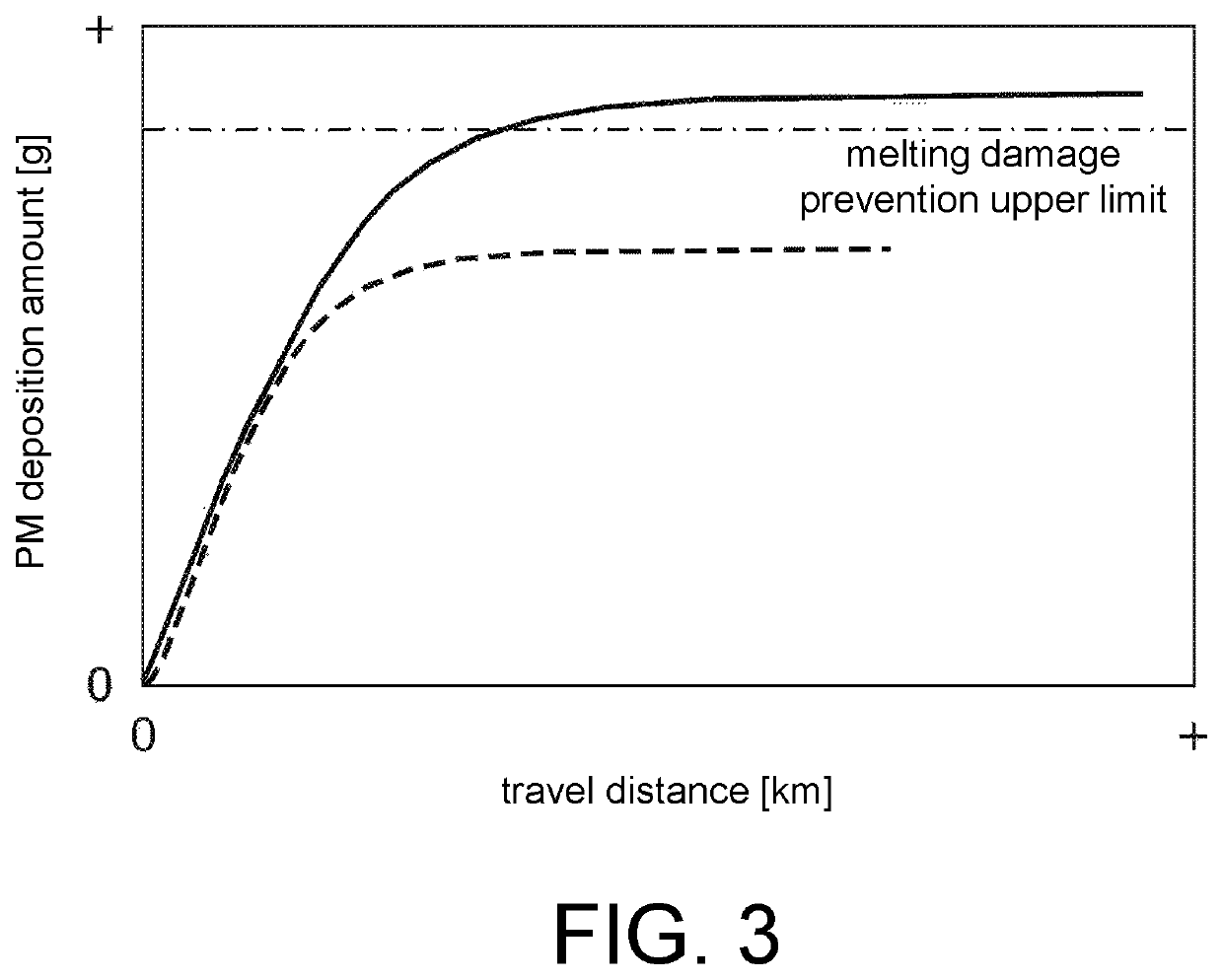[0030]Some of particulate matter discharged from the engine and captured by the filter that has not been combusted with heat of exhaust is deposited in the filter. Thus, it is important to know the amount of the particulate matter combusted in the filter in order to prevent excessive deposition in the filter with efficiency. Therefore, the hybrid vehicle of the present disclosure performs the motor drive control for rotating the output shaft of the engine with the motor when the filter-correlated temperature is higher than or equal to the reference temperature and the particulate matter combustion amount that is an integration amount of particulate matter combusted in the filter is smaller than the combustion amount threshold. Accordingly, the motor drive control is executed when the particulate matter combustion amount is smaller than the combustion amount threshold, that is, particulate matter needs to be actively combusted to prevent excessive deposition, and the combustion of the particulate matter deposited in the filter can be promoted. In addition, the motor drive control can be prevented from being performed when the particulate matter combustion amount is greater than or equal to the combustion amount threshold, that is, most particulate matter captured in the filter has already been combusted and thus excessive deposition will not occur. Accordingly, waste of energy such as a fuel and electric power for executing the motor drive control can be curbed.
[0031]Particulate matter particularly increases immediately after a start of the engine and is discharged from the engine. Thus, the control part calculates the combustion integration amount of particulate matter combusted in the filter immediately after the start of the engine when a particularly large amount of particulate matter can be discharged, sets the amount as the particulate matter combustion amount, and determines a timing at which the motor drive control is executed based on the particulate matter combustion amount. Accordingly, the motor drive control can be executed at the right time, and further waste of energy needed for executing the motor drive control can be curbed. In addition, in the present disclosure, the control part assumes that the allowable upper limit amount of particulate matter has been deposited in the filter when calculating the particulate matter combustion amount. As the deposition amount of particulate in the filter increases, the amount of particulate matter combusted in the filter increases as described above, and thus the particulate matter combustion amount is estimated to be greater than the actual amount. Thus, according to the present disclosure, the execution frequency of the motor drive control is lower than when the particulate matter combustion amount is calculated using the actual particulate matter deposition amount, and thus waste of energy such as a fuel and electric power for executing the motor drive control can be curbed accordingly. However, while there is concern of the particulate matter deposition amount increasing in the filter due to the low execution frequency of the motor drive control in this case, the particulate matter combustion amount is calculated on the assumption that the allowable upper limit amount of particulate matter has been deposited in the filter according to the present disclosure as described above, and thus it is possible to prevent the actual deposition amount from exceeding the allowable upper limit amount.
[0032]According to the embodiment, the control part may calculate the particulate matter combustion amount based on the filter-correlated temperature correlated with the particulate matter combustion amount and an operation state of the engine. Accordingly, since the particulate matter combustion amount can be calculated with high accuracy, the motor drive control can be executed at the right time, and further waste of energy needed for executing the motor drive control can be curbed.
[0033]As will be described below with reference to FIG. 5, the discharge integration amount of particulate matter discharged from the start of the engine significantly increases in the process of warm-up of the engine. Thus, the control part may set the discharge integration amount of particulate matter discharged from the start of the engine as the combustion amount threshold that is the threshold with respect to the particulate matter combustion amount. Accordingly, the motor drive control can be executed at the right time in the process of warm-up of the engine in which the deposition amount is likely to significantly increase.
[0034]According to the embodiment, the control part may calculate the combustion amount threshold that is the discharge integration amount of the particulate matter discharged from the start of the engine based on an engine RPM, an intake air amount, and an engine water temperature. Accordingly, since the combustion amount threshold can be calculated with high accuracy, the motor drive control can be executed at the right time, and further waste of energy needed for executing the motor drive control can be curbed.
[0035]According to the embodiment, when the start-time water temperature is in the predetermined temperature-rise range, the control part may execute temperature rise control, and thereby temperatures of the engine and exhaust of the engine are raised and further exhaust purification performance of the exhaust purification device is improved. In addition, when such temperature rise control is executed, the temperature of the exhaust increases, and thus particulate matter captured in the filter is combusted accordingly. However, when the start-time water temperature is excessively low, more specifically, when the start-time water temperature is lower than the lower limit of the temperature-rise range, it is difficult to improve the exhaust purification performance in an early stage even if the temperature rise control is performed, there is concern of fuel efficiency deteriorating, and therefore the control part does not execute the temperature rise control. Thus, when the start-time water temperature is equal to or lower than the lower limit of the temperature-rise range and the temperature rise control is not executed, the control part performs the motor drive control. Accordingly, excessive deposition in the filter can be prevented at the time of a low-temperature start of the vehicle at which the deposition amount of particulate matter easily increases in the filter.
[0036]When the start-time water temperature is in the predetermined temperature-rise range as described above, while the temperature rise control is executed, the deposition amount of particulate matter in the filter may gently increase and exceed the allowable upper limit amount. Thus, when the deposition amount exceeds the start threshold in a state in which the start-time water temperature is higher than or equal to the lower limit of the temperature-rise range, the control part performs the motor drive control until the deposition amount becomes equal to or smaller than the end threshold. Accordingly, it is possible to prevent the deposition amount from greatly exceeding the allowable upper limit amount.
[0037]Since gasoline engines have a higher exhaust temperature than diesel engines, the deposition amount of particulate matter of the filter tends to converge on a predetermined saturated deposition amount even if a forced regeneration process as in DPFs used in diesel engines is not periodically performed. However, since the chances for hybrid vehicles in which gasoline engines are mounted to execute fuel cutting to promote combustion of particulate matters as described above are limited, the saturated deposition amount may exceed the allowable upper limit amount that is determined to prevent melting damage of the filter. With respect to this, the control part performs the motor drive control for rotating the output shaft of the engine with the motor when the filter-correlated temperature is higher than or equal to the reference temperature and the particulate matter combustion amount is smaller than the combustion amount threshold. Accordingly, the motor drive control can be performed at the right timing to prevent the saturated deposition amount from exceeding the allowable upper limit amount.
[0038]When the travel range is not the forward range, or the vehicle speed is lower than the reference vehicle speed, a sufficient amount of air is not supplied to the filter even if the motor drive control is executed, and the effect of combusting particulate matter is small. In addition, since it is difficult to generate a driving force with the engine in the motor drive control, if the motor drive control is executed in a state in which a required driving force is greater than the reference driving force, a driving force according to the required driving force may not be generated and power performance of the vehicle may deteriorate. Thus, the control part executes the motor drive control on the condition that the travel range is the forward range, the vehicle speed is higher than or equal to the predetermined reference vehicle speed, and the required driving force is smaller than the predetermined reference driving force. Accordingly, the motor drive control can be executed without lowering the power performance of the vehicle, and particulate matter can be effectively combusted through the motor drive control.
 Login to View More
Login to View More  Login to View More
Login to View More 


